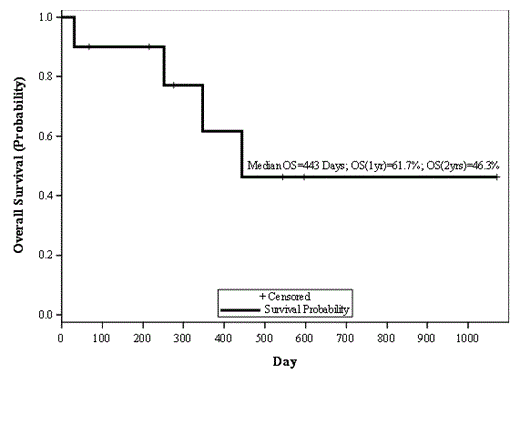Abstract
Allogeneic stem cell transplantation (SCT) using HLA-haploidentical (HAPLO) related donors has been an effective strategy for treating hematologic malignancies in patients who lack a matched donor. In multiple myeloma (MM), allogeneic SCT used in tandem or as salvage therapy can be a potentially curative option, however, there is little data regarding the use of HAPLO donors in this population.
We report 10 patients with MM who received HAPLO allografts between 2011-2014. Median age was 53 (range 28-61) and 5 patients were male. All patients, except one, were relapsed or refractory to at least 1 prior autograft. Patients with pre-transplant CD4 counts >200/uL received a fludarabine (Flu)-based regimen for in-vivo lymphodepletion to prevent graft rejection. Conditioning regimen for transplantation was Flu 30 mg/m2 daily x5 with cyclophosphamide (Cy) 14.5 mg/kg daily x 2, followed by TBI 200-400 cGY in 1 or 2 fractions. Post-transplant immunosuppression consisted of Cy 50-60 mg/kg on days +3 and +4, followed by tacrolimus and mycophenolate starting on day +5. All patients received filgrastim starting on day +5. Six patients received bone marrow (BM) with a median cell dose of 2.76 x 10e6 CD34cells/kg (range 1.1-4.02) and 4 patients received peripheral blood stem cells (PBSC) with a median cell dose 4.01 x 10e6 CD34 cells/kg (range 1.05-4.04).
One patient developed sepsis on day +14 and died on day +31 without hematologic recovery. All other patients achieved engraftment, with median neutrophil engraftment of 18 days (range 14-45) and median platelet engraftment of 21 days (range 14-53). There was no difference between engraftment for BM or PBSC. Median time to neutrophil engraftment was 17 days for BM and 19.5 days for PBSC (p=ns). Median time to platelet engraftment was 29 days for BM and 20.5 days for PBSC(p=ns). Median time to full donor chimerism was 32 days overall (range 27-61); 38 days for BM (range 29-61) and 27.5 days for PBSC (range 27-32).
At a median follow up of 10 months (range 1-35), 6 patients are alive. Of those, 2 patients are in CR, 3 in VGPR, and 1 with stable disease (SD). The 2 year overall survival is 46%. The causes of death for 4 patients were sepsis (1), progressive disease (2), and chronic inflammatory demyelinating polyneuropathy (CIDP) (1). Eight patients developed acute graft versus host disease (GVHD), with one having grade III, and 7 with grade I-II. Five patients were treated for chronic GVHD, 3 mild and 2 moderate by NIH criteria. None of the deceased patients developed chronic GHVD and all of the surviving patients had chronic GVHD, except for 1 who is prior to day +100 at the time of this report. Four patients were treated for grade 3 infections, with 1 infection-related death.
Five patients relapsed or progressed their disease after HAPLO transplant, with a median time to progression of 7.8 months (range 3.2-11.4). Of these, 1 is in VGPR after salvage therapy, 1 has SD after salvage therapy and donor lymphocyte infusion, 2 died from relapse and 1died from CIDP. KIR typing was available for 8 recipient and donor pairs. There were 2 KIR B/x to A/A transplants, with1 patient deceased and 1 alive. All of the 4 KIR B/x to B/x recipients are alive, and the 2 KIR A/A to B/x recipients are deceased.
This small series suggests HAPLO transplantation can be used in patients with advanced MM who are without a suitable matched donor. Our patients achieved timely hematologic engraftment and donor chimerism with BM or PBSC. There was no fatal acute GVHD, and as previously reported, chronic GVHD may be protective against relapse. Further studies need to be done to further elucidate the impact of KIR typing on transplant outcomes.
Overall Survival
No relevant conflicts of interest to declare.
Author notes
Asterisk with author names denotes non-ASH members.


This feature is available to Subscribers Only
Sign In or Create an Account Close Modal